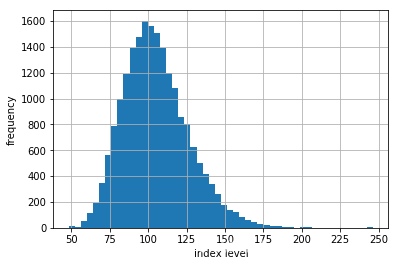12 Python总结之蒙特卡洛模拟
本文共 5245 字,大约阅读时间需要 17 分钟。
蒙特卡洛模拟
蒙特卡洛模拟是金融学和数值科学中最重要的算法之一。它之所以重要,是因为在期权定价或者风险管理问题上有很强的能力。和其它数值方法相比,蒙特卡洛方法很容易处理高维问题,在这种问题上复杂度和计算需求通常以线性方式增大。
蒙特卡洛方法的缺点是:它本身是高计算需求的,即使对于相当简单的问题也往往需要海量的计算。因此,必须高效的实现蒙特卡洛算法。
下面使用不同的方法实现蒙特卡洛算法
1.Scipy
2.纯Python
3.向量化Numpy
4.全向量化Numpy
方法一:Scipy
欧式看涨期权的定价公式Black-Scholes-Merton(1973):

其中:


C—期权初始合理价格
L—期权交割价格
S—所交易金融资产现价
T—期权有效期
r—连续复利计无风险利率
σ2—年度化方差
N()—正态分布变量的累积概率分布函数
# 导用到的库from math import log, sqrt, expfrom scipy import stats
# 期权的定价计算,根据公式1.def bsm_call_value(S_0, K, T, r, sigma): S_0 = float(S_0) d_1 = (log(S_0 / K) + (r + 0.5 *sigma **2) *T)/(sigma * sqrt(T)) d_2 = (log(S_0 / K) + (r - 0.5 *sigma **2) *T)/(sigma * sqrt(T)) C_0 = (S_0 * stats.norm.cdf(d_1, 0.0, 1.0) - K * exp(-r * T) * stats.norm.cdf(d_2, 0.0, 1.0)) return C_0
# 计算的一些初始值S_0 = 100.0 # 股票或指数初始的价格;K = 105 # 行权价格T = 1.0 # 期权的到期年限(距离到期日时间间隔)r = 0.05 # 无风险利率sigma = 0.2 # 波动率(收益标准差)
# 到期期权价值%time print (bsm_call_value(S_0, K, T, r, sigma))
8.021352235143176Wall time: 511 µs
方法二:Python
下面的计算仍基于BSM(balck-scholes-merton),模型中的高风险标识(股票指数)在风险中立的情况下遵循以随机微分方程(SDE)表示的布朗运动.


# 导入python模块from time import timefrom math import exp, sqrt, logfrom random import gauss, seed
seed(2000)# 计算的一些初始值S_0 = 100.0 # 股票或指数初始的价格;K = 105 # 行权价格T = 1.0 # 期权的到期年限(距离到期日时间间隔)r = 0.05 # 无风险利率sigma = 0.2 # 波动率(收益标准差)M = 50 # number of time stepsdt = T/M # time entervalI = 20000 # number of simulation
start = time()S = [] # for i in range(I): path = [] # 时间间隔上的模拟路径 for t in range(M+1): if t==0: path.append(S_0) else: z = gauss(0.0, 1.0) S_t = path[t-1] * exp((r-0.5*sigma**2) * dt + sigma * sqrt(dt) * z) path.append(S_t) S.append(path)# 计算期权现值C_0 = exp(-r * T) *sum([max(path[-1] -K, 0) for path in S])/Itotal_time = time() - startprint ('European Option value %.6f'% C_0)print ('total time is %.6f seconds'% total_time) European Option value 8.159995total time is 1.616999 seconds
前三十条模拟路径
# 选取部分模拟路径可视化import matplotlib.pyplot as plt %matplotlib inline plt.figure(figsize=(10,7))plt.grid(True)plt.xlabel('Time step')plt.ylabel('index level')for i in range(30): plt.plot(S[i]) 
方法三: 向量化的Numpy
使用numpy的一些数组,来减少运算
# 导入模块import numpy as npfrom time import time
# 计算的一些初始值S_0 = 100.0 # 股票或指数初始的价格;K = 105 # 行权价格T = 1.0 # 期权的到期年限(距离到期日时间间隔)r = 0.05 # 无风险利率sigma = 0.2 # 波动率(收益标准差)M = 50 # number of time stepsdt = T/M # time entervalI = 20000 # number of simulation
# 20000条模拟路径,每条路径50个时间步数S = np.zeros((M+1, I))S[0] = S_0np.random.seed(2000)start = time()for t in range(1, M+1): z = np.random.standard_normal(I) S[t] = S[t-1] * np.exp((r- 0.5 * sigma **2)* dt + sigma * np.sqrt(dt)*z)C_0 = np.exp(-r * T)* np.sum(np.maximum(S[-1] - K, 0))/Iend = time()
# 估值结果print ('total time is %.6f seconds'%(end-start))print ('European Option Value %.6f'%C_0) total time is 0.039680 secondsEuropean Option Value 7.993282
前20条模拟路径
# 前20条模拟路径import matplotlib.pyplot as plt%matplotlib inline plt.figure(figsize=(10,7))plt.grid(True)plt.xlabel('Time step')plt.ylabel('index level')for i in range(20): plt.plot(S.T[i]) 
到期指数模拟水平
# 到期时所有模拟指数水平的频率直方图%matplotlib inlineplt.hist(S[-1], bins=50)plt.grid(True)plt.xlabel('index level')plt.ylabel('frequency') Text(0, 0.5, 'frequency')

到期期权内在价值
# 模拟期权到期日的内在价值%matplotlib inlineplt.hist(np.maximum(S[-1]-K, 0), bins=50)plt.grid(True)plt.xlabel('option inner value')plt.ylabel('frequency') Text(0, 0.5, 'frequency')

方法四:全向量化的Numpy

import numpy as npfrom time import time
# 计算的一些初始值S_0 = 100.0 # 股票或指数初始的价格;K = 105 # 行权价格T = 1.0 # 期权的到期年限(距离到期日时间间隔)r = 0.05 # 无风险利率sigma = 0.2 # 波动率(收益标准差)M = 50 # number of time stepsdt = T/M # time entervalI = 20000 # number of simulation
np.random.seed(2000)start = time()# 生成一个随机变量的数组,M+1行,I列# 同时计算出没一条路径,每一个时间点的指数水平的增量# np.cumsum(axis=0),在列的方向上进行累加得到每一个时间步数上的指数水平S = S_0 * np.exp(np.cumsum((r - 0.5*sigma **2) *dt +sigma *np.sqrt(dt) *np.random.standard_normal((M+1, I)),axis=0))S [0] = S_0C_0 = np.exp(-r * T) * np.sum(np.maximum(S[-1] - K, 0))/Iend = time()
print ('toatl time is %.6f seconds'%(end-start))print ('Europaen Option Value %.6f'%C_0) toatl time is 0.077348 secondsEuropaen Option Value 8.113643
前20条模拟路径
# 前20条模拟路径import matplotlib.pyplot as plt%matplotlib inline plt.figure(figsize=(10,7))plt.grid(True)plt.xlabel('Time step')plt.ylabel('index level')plt.plot(S[:,:20]) [, , , , , , , , , , , , , , , , , , , ]

模拟到期指数水平
# 到期时所有模拟指数水平的频率直方图import matplotlib.pyplot as plt%matplotlib inlineplt.hist(S[-1], bins=50)plt.grid(True)plt.xlabel('index level')plt.ylabel('frequency') Text(0, 0.5, 'frequency')

模拟到期期权内在价值
# 模拟期权到期日的内在价值%matplotlib inlineplt.hist(np.maximum(S[-1]-K, 0), bins=50)plt.grid(True)plt.xlabel('option inner value')plt.ylabel('frequency') Text(0, 0.5, 'frequency')

sum(S[-1] < K) # 在两万次模拟中超过一万次到期期权内在价值为0
10748
结果对比
1.Scipy,估值结果:8.021352,耗时:511 µs
2.Python,估值结果:8.159995,耗时:1.616999s
3.向量化Numpy,估值结果:7.993282,耗时:0.039680s
4.完全向量化Numpy,估值结果:8.113643,耗时:0.077348
Scipy,用时最短是因为,沒有进行20000次的模拟估值.其他三个方法进行了20000次的模拟,基于Numpy的计算方法速度比较快.
转载地址:http://sdzdf.baihongyu.com/
你可能感兴趣的文章
开源项目|软件包应用作品:通用物联网系统平台
查看>>
【经验分享】RT-Thread UART设备驱动框架初体验(中断方式接收带\r\n的数据)
查看>>
RT-Thread 编程风格指南
查看>>
Cache 的基本概念与工作原理
查看>>
Android程序员必备!面试一路绿灯Offer拿到手软,Android面试题及解析
查看>>
Android开发知识体系!腾讯+字节+阿里面经真题汇总,成功入职阿里
查看>>
typescript学习(进阶)
查看>>
三天敲一个前后端分离的员工管理系统
查看>>
Cookie、Session
查看>>
表单重复提交
查看>>
Filter
查看>>
微服务架构实施原理详解
查看>>
必须了解的mysql三大日志-binlog、redo log和undo log
查看>>
Uniform Grid Quadtree kd树 Bounding Volume Hierarchy R树 搜索
查看>>
局部敏感哈希Locality Sensitive Hashing归总
查看>>
图像检索中为什么仍用BOW和LSH
查看>>
图˙谱˙马尔可夫过程˙聚类结构----by林达华
查看>>
深度学习读书笔记之AE(自动编码AutoEncoder)
查看>>
深度学习读书笔记之RBM
查看>>
深度学习word2vec笔记之基础篇
查看>>